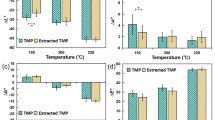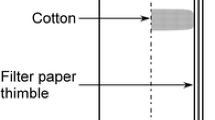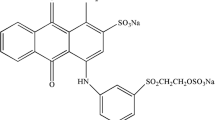Abstract
The effects of borate and glycerol impregnation of Douglas-fir heartwood prior to open-air oven thermal modification at 160–200 °C for 2–4 h on wood color were measured. These materials were used to analyze the effects of modifying agents on thermal decomposition of wood by color nondestructive assessments. Kinetic analysis using time–temperature superposition and the horizontal shift factor were employed to quantify color changes. Lightness values were significantly affected by heating time and temperature, while red/green and yellow/blue values were significantly affected by pretreatments and thermal modification temperatures. Total color differences tended to increase with heating temperature and time. The calculated values of the apparent activation energy on non-impregnated, borate-impregnated and glycerol-impregnated wood ranged from 94.9 to 126.4 kJ/mol, 46.5 to 74.3 kJ/mol and 54.3 to 79.7 kJ/mol, respectively. The results suggest that borate and glycerol decreased the apparent activation energy of thermal degradation reactions and could function as a catalyst to accelerate thermal modification. Time–temperature superposition color kinetic analysis could be used to assess the effects of modifying agents on thermal decomposition.




Similar content being viewed by others

References
Badini C, Saracco G, Russo N, Specchia V (2000) A screening study on the activation energy of vanadate-based catalysts for diesel soot combustion. Catal Lett 69:207–215
Bekhta P, Niemz P (2003) Effect of high temperature on the changes in color, dimensional stability and mechanical properties of spruce wood. Holzforschung 57:539–546
Brischke C, Welzbacher CR, Brandt K, Rapp AO (2007) Quality control of thermally modified timber: interrelationship between heat treatment intensities and CIE L* a* b* color data on homogenized wood samples. Holzforschung 61:19–22
Calonego FW, Severo ETD, Furtado EL (2010) Decay resistance of thermally-modified Eucalyptus grandis wood at 140 °C, 160 °C, 180 °C, 200 °C and 220 °C. Bioresour Technol 101(23):9391–9394
Chen Y, Tshabalala MA, Gao J, Stark NM, Fan Y (2014) Color and surface chemistry changes of extracted wood flour after heating at 120 °C. Wood Sci Technol 48:137–150
Ding HZ, Wang ZD (2007) Time–temperature superposition method for predicting the permanence of paper by extrapolating accelerated ageing data to ambient conditions. Cellulose 14:171–181
Esteves BM, Pereira HM (2009) Wood modification by heat treatment: a review. BioResources 4(1):370–404
Esteves BM, Doningos IJ, Pereira HM (2008a) Pine wood modification by heat treatment in air. BioResources 3(1):142–154
Esteves B, Velez MA, Domingos I, Pereira H (2008b) Heat-induced colour changes of pine (Pinus pinaster) and eucalypt (Eucalyptus globulus) wood. Wood Sci Technol 42(5):369–384
Fengel D, Wegener G (1989) Wood: chemistry, ultrastructure, reactions. Walter de Gruyter, Berlin, p 26
Goli G, Marcon B, Fioravanti M (2014) Poplar wood heat treatment: effect of air ventilation rate and initial moisture content on reaction kinetics, physical and mechanical properties. Wood Sci Technol 48(6):1303–1316
Johansson D, Morén T (2006) The potential of colour measurement for strength prediction of thermally treated wood. Holz Roh Werkst 64:104–110
Lekounougou S, Kocaefe D (2014) Effect of thermal modification temperature on the mechanical properties, dimensional stability, and biological durability of black spruce (Picea mariana). Wood Mat Sci Eng 9(2):59–66
Luo S, Cao J, Wang X (2013) Investigation of the interfacial compatibility of PEG and thermally modified wood flour/polypropylene composites using the stress relaxation approach. BioResources 8(2):2064–2073
Marcon B, Goli G, Matsuo M, Gril J, Kawai S (2018) Kinetic analysis of poplar wood properties by thermal modification in conventional oven. iForest 11:131–139
Matsumura Y, Okumura M, Usami Y, Kagawa K, Yamashita H, Anpo M, Haruta M (1997) Low-temperature decomposition of methanol to carbon monoxide and hydrogen with low activation energy over Pd/ZrO2 catalyst. Catal Lett 44:189–191
Matsunaga M, Obataya E, Minato K, Nakatsubo F (2000) Working mechanism of adsorbed water on the vibrational properties of wood impregnated with extractives of pernambuco (Guilandina echinata Spreng.). J Wood Sci 46:122–129
Matsuo M, Yokoyama M, Umemura K, Gril J, Yano K, Kawai S (2010) Color changes in wood during heating: kinetic analysis by applying a time–temperature superposition method. Appl Phys A 99:47–52
Matsuo M, Yokoyama M, Umemura K, Sugiyama J, Kawai S, Gril J, Kubodera S, Mitsutani T, Ozali H, Sakamoto M, Imamura M (2011) Aging of wood: analysis of color changes in cellulose during heat treatment. J Wood Sci 58:113–119
Matsuo M, Umemura K, Kawai S (2012) Kinetic analysis of color changes in cellulose during heat treatment. J Wood Sci 58:113–119
Matsuo M, Umemura K, Kawai S (2014) Kinetic analysis of color changes in keyaki (zelkova serrata) and sugi (Cryptomeria japonica) wood during heat treatment. J Wood Sci 60:12–20
Matsuo MU, Mitsui K, Kobayshi I, Kohara M, Yoshida M, Yamamoto H (2016) Effect of hygrothermal treatment on wood properties: color changes and kinetic analysis using four softwood and seven hardwood species. Wood Sci Technol 50:1145–1160
Mitsui K, Takada H, Sugiyama M, Hasegawa R (2001) Changes in the properties of light-irradiated wood with heat treatment. Part 1. Effect of treatment conditions on the change in color. Holzforschung 55:601–605
Obataya E, Minato K (2009) Potassium acetate-catalyzed acetylation of wood at low temperatures II: vapor phase acetylation at room temperature. J Wood Sci 55:23–26
Olarescu MC, Ispas CM, Cosereanu C (2014) Effect of thermal treatment on some properties of lime wood. Eur J Wood Prod 72:559–562
Poncsάk S, Kocaefe D, Bouazara M, Pichette A (2006) Effect of high temperature on the mechanical properties of birch (Betula papyrifera). Wood Sci Technol 40:647–663
Sandberg D, Kutnar A, Mantanis G (2018) Wood modification technologies—a review. Forest 10:895–908
Tjeerdsma B, Boonstra M, Pizzi A, Tekely P, Militz H (1998) Characterisation of thermally modified wood: molecular reasons for wood performance improvement. Holz Roh Werkst 56:149–153
Toshimi H (1995) Kinetics of pyrolysis of wood and cellulose. Mokuzai Gakkaishi 41(10):879–886
Tuong VM, Li J (2010) Effect of heat treatment on the change in color and dimensional stability of acacia hybrid wood. BioResources 5(2):1257–1267
Yan L, Chen Z (2016) Dynamic mechanical analysis of viscoelastic properties of heat treated glycerol-impregnation poplar wood. International research group on wood protection document no. IRG/WP/16-40732
Yan L, Morrell JJ (2014) Effect of thermal modification on physical and mechanical properties of Douglas-fir heartwood. BioResources 9(4):7152–7161
Yan L, Morrell JJ (2015) Mold and decay resistance of thermally modified Douglas-fir heartwood. For Prod J 65(5/6):272–277
Yan L, Cao J, Jin X (2010) Deformation fixation, mechanical properties and chemical analysis of compressed Populus cathayana wood pretreated by glycerin. For Stud China 12(4):213–217
Yan L, Cao J, Gao W, Zhou X, Zhao G (2011) Interaction between glycerin and wood at various temperatures from stress relaxation approach. Wood Sci Technol 45(6):215–222
Acknowledgements
The senior author is grateful for the support of National Natural Science Foundation of China (NSFC) No. 31400500.
Author information
Authors and Affiliations
Corresponding author
Additional information
Publisher's Note
Springer Nature remains neutral with regard to jurisdictional claims in published maps and institutional affiliations.
Rights and permissions
About this article
Cite this article
Yan, L., Morrell, J.J. Kinetic color analysis for assessing the effects of borate and glycerol on thermal modification of wood. Wood Sci Technol 53, 263–274 (2019). https://doi.org/10.1007/s00226-018-1072-4
Received:
Published:
Issue Date:
DOI: https://doi.org/10.1007/s00226-018-1072-4



